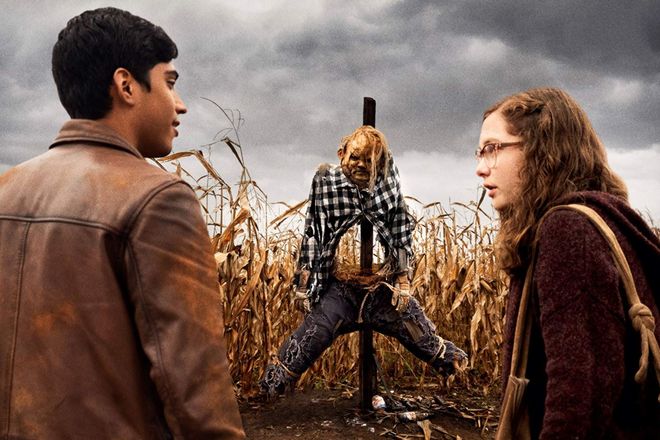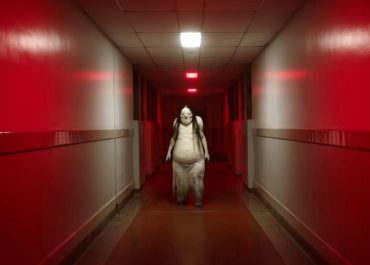Guillermo del Toro writes and produces a horror story based on Alan Schwartz’s children horror potpourri, Scary Stories to Tell in the Dark, catering his own nightmarish vision about a story that reads people, instead of being read. Helmed by André Øvredal (whose horror portfolio includes folk fantasy-horror, Trollhunters, and the downright claustrophobic, supernatural horror, The Autopsy of Jane Doe), the adaptation makes an extravagant fantasy-horror combo. Contrary to the source material, the screen adaptation is a seamless, full-length story that blends elements from the book into a visually striking period horror, which only scarcely scary, but most effective in capturing the classic fright.
“Stories hurt. Stories heal,” the story opens with its credo before bringing us to the ‘season of the witches’ in a small town of Mill Valley, where the titular scary stories take place. The story sets during the dark time of 1968, where Nixon still boasts about ‘Nam, sending young boys to the war soon after they’re coming of ages. It starts off on a Halloween night that, as one character contemplatively but also predictively said, might be their last Halloween night together, which might be true given the setting and, ultimately, the story they will be involved in. With coming-of-age characters, each having their own bitter backstory, Scary Stories to Tell in the Dark emanates the bleak atmosphere of Stephen King’s grimmest stories, yet doubled down with the director and the producer’s penchant of grotesque creatures, whom the movie prides in (as you can see in the series of promotional posters).

in Scary Stories to Tell in the Dark (2019)
The calamity begins when a reclusive girl, Stella (Zoe Margaret Colletti, definitely a star we need to keep tracking on), along with her nerd gang, Chucky (Austin Zajur) and Auggie (Gabriel Rush), dedicate their possibly last Halloween together pranking a school bully (Austin Abrams) only to get themselves tangled in a bigger problem. Escaping with the help of a new kid in town, Ramon (Michael Garza), the kids are trapped in the town’s most malicious haunted house along with Chucky’s older sister (Natalie Ganzhorn). In the house believed to be the place where a town’s outcast, Sarah Bellows, was held captive until she committed suicide, the kids find Sarah’s infamous manuscript known as the cause of children’s demise back then. The very same book containing scary stories believed to be written with blood is the Macguffin—the culprit of all nightmares to come a.k.a. the book which reads the children, specifically their personal scary stories.
From there, Scary Stories to Tell in the Dark begins flaunting its prized scary monster. Like in most Stephen King’s most harrowing stories, this movie doesn’t shy away from sending young and likable characters to their demise and that’s what makes it traumatizing. Tell any of it in a campfire and kids will be traumatized until at least they’ve come of age. Del Toro, who writes the story with Patrick Melton and Marcus Dunstan, incorporates several horror stories from the book series and stitches them into one comprehensive story using Stell and the other kids as the subjects. Scary Stories marks each story with a disturbingly unique creature of nightmare. The thing is, not every story has the same fright energy that keeps the movie balance. “Harold”, the story involving the school bully is undoubtedly the strongest of all; it’s been given enough portion of scares and, most importantly, an integral part of the whole narrative. “The Red Room” has promising set-pieces and terrifying sequences, but it’s troubled with its position in the narrative. Other stories like the one with an actual toe and a red spot are pale in comparison to the movie’s strongest stories.
The scary creatures are possibly the greatest elements in Scary Stories to remember far after the movie finishes. In this case, the scarecrow from Harold becomes the face of Scary Stories adaptation; The Jangly Man also makes an unforgettable entrance, but, it’s the pale woman who disturbs the most. Øvredal adeptly uses those creatures to create some spectacles, even when they’re not as scary as you might imagine. The problem is Øvredal somehow loves to drag the scares, which makes most of it losing the momentum. The stretched fright might work well in The Autopsy of Jane Done given the actual scale of the movie and, of course, the set; but, Scary Stories is a different beast and the same treatment clearly doesn’t work.
Even when Scary Stories to Tell in the Dark is not as coherent and balance as del Toro’s finest horrors as in The Devil’s Backbone or Pan’s Labyrinth; and it is not as harrowing as Øvredal’s previous works, the combo, as expected, makes an effective fantasy horror with unforgettable grotesque creature designs. There’s an indication that this movie might aim for a sequel; however, if a sequel can actually be conceived, the filmmakers need to address the story frame and make sure that it will not be the same-old presentation. Given the bank of scary stories they haven’t explored from the book, the idea needs anticipations.

[imdb style=”transparent”]tt3387520[/imdb]


Leave a Reply